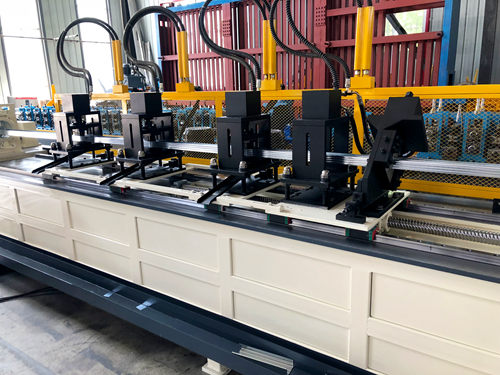
The Advantages of Storage Box Beam Roll Forming Machines
In the realm of modern manufacturing, efficiency and precision are paramount. One of the innovative technologies that have transformed the production of various metal components is the storage box beam roll forming machine. This sophisticated machinery has gained popularity due to its ability to produce high-quality steel beams, widely used in constructing storage boxes, warehouses, and other industrial applications. In this article, we will explore the advantages of using a storage box beam roll forming machine, its applications, and its impact on the manufacturing industry.
Understanding Roll Forming Technology
Roll forming is a continuous bending operation in which a long strip of metal, usually coiled steel, is fed through consecutive rolls to achieve the desired cross-sectional shape. The process involves gradually shaping the metal without any cutting operations, ensuring minimal waste and high efficiency. Roll forming machines are designed to work with various materials, including steel, aluminum, and copper, making them versatile for different applications.
Key Advantages of Storage Box Beam Roll Forming Machines
1. High Production Efficiency One of the most significant benefits of using a storage box beam roll forming machine is its ability to produce large quantities of beams in a short time. The continuous operation ensures that manufacturers can meet high demand without compromising quality.
2. Precision and Consistency Roll forming machines are engineered for precision. The products created, such as storage box beams, have uniform dimensions and consistent quality, which is critical for structural applications. This level of accuracy reduces the need for further processing and minimizes waste.
3. Cost-Effective Manufacturing The efficient nature of roll forming translates to lower operational costs. With reduced waste, less energy consumption, and faster production times, manufacturers can achieve greater profit margins compared to traditional manufacturing methods.

4. Versatility in Design Storage box beam roll forming machines can be customized to produce beams of various shapes and sizes. This flexibility allows manufacturers to cater to specific market needs or project requirements, making it suitable for different industries such as construction, logistics, and storage solutions.
5. Durability and Strength The beams produced by roll forming machines are typically made from high-strength steel, which provides excellent durability and load-bearing capacity. This makes them ideal for use in heavy-duty applications, ensuring that storage boxes can withstand significant weight and environmental stresses.
6. Eco-Friendly Manufacturing Roll forming is a more sustainable manufacturing process compared to others, as it generates less scrap and maximizes material usage. Furthermore, steel is a recyclable material, allowing manufacturers to contribute to environmental conservation efforts.
Applications of Storage Box Beam Roll Forming Machines
Storage box beams are essential in various sectors, including
- Construction Used in building frameworks, storage facilities, and warehouses, these beams provide the necessary support and structural integrity. - Logistics Storage box beams are crucial in designing systems for efficient handling and storage of goods, enhancing warehouse management. - Automotive The automotive industry also benefits from these beams as they are employed in the manufacturing of storage solutions for vehicles.
Conclusion
The storage box beam roll forming machine represents a significant advancement in manufacturing technology. With its high efficiency, precision, and eco-friendly nature, it is poised to play a vital role in meeting the growing demand for structural steel components in various industries. As manufacturers continue to seek out innovative solutions to improve productivity and reduce costs, the role of roll forming machinery will undoubtedly expand, driving the industry towards a more sustainable and efficient future. Investing in such technology not only enhances production capabilities but also strengthens the overall manufacturing landscape.